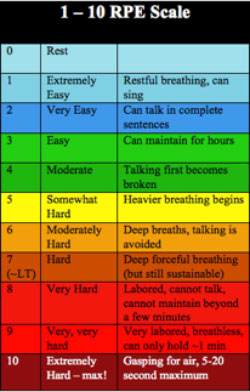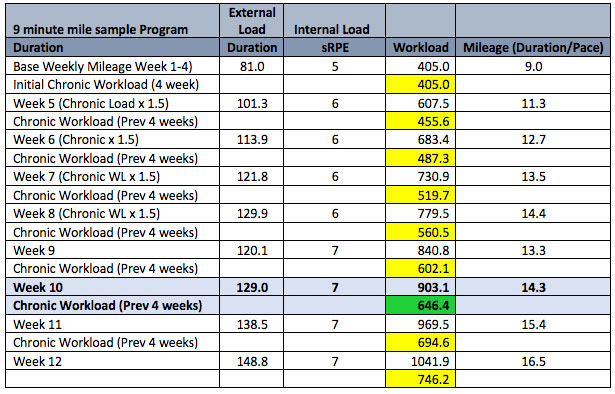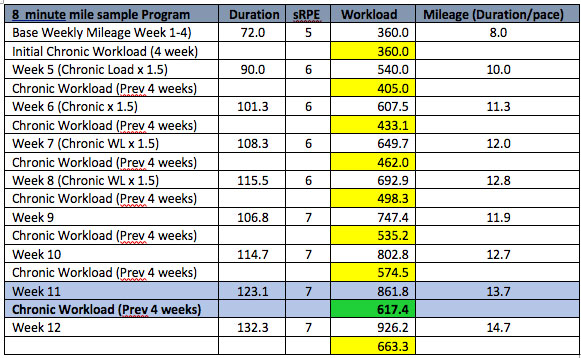The Reno-Tahoe Odyssey is just around the corner! Have you started training yet? If you were like me, you figured a few miles, a couple times a week in February (ok, March) would be a good start. Never really had a plan, just try to not die the first few weeks and then just figured I'd add a few miles each week and hope it was enough when the RTO came. Sometimes it was. Usually it wasn't. Over the last few years, Tim Gabbett (gabbettperformance.com) has been leading the charge on sports science and injury reduction. Tim's work has primarily been in establishing the concepts of Acute:Chronic Workload ratios. What does that mean and what does it have to do with the RTO?? Let's first define some terms:
Internal Load: The time or duration of the work being done. For this conversation, this is miles run x pace per mile. E.g. 9 minute mile x 4 miles = 36.
External Load: How hard was it?? Most recommend using the Rate of Perceived Exertion (RPE) Scale pictured below. Generally rated from 0 (asleep) to 10 (maximum effort failure, i.e. did not complete the race).
Acute Workload: Internal Load multiplied by External load for the week. So, say you ran a 10 min/mile for 5 miles at an RPE of 6. Your session workload is External x Internal Load = 10 x 5 x 6 = 300 AU (AU = arbitrary units). If you repeated this three times that week, your acute workload for the week is 300 x 3 = 900 AU.
Chronic Workload: Your rolling average of the Acute workload of the previous 4 weeks. As we'll explain later, this may look like 900 AU for week 1, 1000 AU week 2, 800 week 3, and 1100 week 4 = 3800/4 = 950 AU chronic workload.

Great, so the terms are defined but why should you care? Here's what we know from the scientific literature: 1) The majority (51%) of hamstring injuries in the NFL occur in the preseason. (Elliot et al., 2014) 2) Nearly half of ACL re-tears occur in the first two months of being cleared to return to play. 3) Athletes who have had a recent increase in loading or a training volume spike have an elevated risk of re-injury for up to 4 weeks. (Orchard et al., 2009). What does this mean? It may mean that these athletes did not establish an appropriate chronic workload to handle the demands of their acute (current week) workload! We see this throughout the literature and managing chronic workload is one of the biggest developments in injury risk reduction in years! So how do you calculate your numbers??
The Math: Part 1
It's actually quite simple. We have three numbers we need. The first is the external load or duration of your workout. For this article we can just use time of the run but to get our initial numbers we estimate the mile pace to give context. In this example, we use a 9-minute mile x 3 miles so our External Load is 27. The second number is the Session Rate of Perceived Exertion or sRPE. You can see a sample scale on the left. This is your Internal Load or how hard was this workout. When we multiple these numbers we have our session workload. In this example, we estimate a sRPE of 5 so our session workload is: 27 X 5 = 135 Arbitrary Units (AU). We total all of the workouts for the week and in this example, we estimate 3 workouts (135 x 3) which equals 405 AU and we now have an acute workload (AW). So, 3 miles, 3 x per week, at an sRPE of 5 = 405 AU.

The Math: Part 2
So to recap: If we start at a conservative 3 miles at a 9-minute mile pace (external load= mile pace multiplied by distance or total time running) at an RPE of 5 (internal load) and 3 days a week (frequency) that gives us an acute workload of 135 AU (arbitrary units) for this specific run. Three times per week, that puts the acute workload for the week at 405 AU. Based off the science previously mentioned, we need to establish an exploratory chronic workload. That means picking a volume that we feel is well tolerated and can be repeated easily over the next 4 weeks. We recommend repeating this 9-min/mile, 3-mile course for 4 weeks to establish an appropriate chronic workload. This exploratory block may look different for different people. If you're brand new to running, then it might be a run-walk progression, if you're more advanced, then adjust your duration and RPE accordingly. The goal of this article is to teach the general ideas that any athlete can apply to any skill level. So, if we take the average of these 4 weeks (405 x 4 divided by the previous 4 weeks) we get 405 AU (surprise!) and now have a chronic workload we can progress off of consistent with the best available science to minimize injury risk.

Week 5, our first workload progression, we multiply our now well-established chronic workload times 1.5 to stay within the safe zone. The literature Gabbett has put out from analyzing hundreds of athletes shows an increase in acute workload of 1.5 or less of the chronic workload seems to be the magic number. Remember, the chronic workload is a rolling average of the previous 4 weeks. Many running programs just blanketly add mileage with no accounting for exertion (RPE). We can multiply each week by 1.5 times the average of the previous 4 weeks; a common mistake is to multiply each week by 1.5 but that shoves the workload into exceeding our tissue's tolerances. Always heed the average!
For the next training block we can increase our intensity to an RPE of 6 and using the same distances, the math gives us a workload of 607 AU which is the acute workload of that week (see the sample protocols at the end of this article). Rolling this average moves our chronic load to 455 AUs, or roughly an 11% increase. Still with me?? Each week we increase our acute load by 1.5x the chronic load and then re-average. This is the science established by Tim Gabbett and his people on injury risk reduction and why this program is so remarkably different; it's science. You can see in the charts what this looks like. The beauty of this model is if a run was a higher RPE than expected, we just decrease our mileage to hit our number. This might be a hill course or just a day when you got no sleep and your 13-month old decided the night before your big run was a good time for a molar to pop up!
What does this mean? It means the number that ties this all together is sRPE. If your sRPE is higher than expected, then your duration (mileage pace x time) needs to come down to stay within these goals. Think of it like money; you get 100 bucks and you can buy five 20-dollar meals or two 10-dollar meals and then splurge on 80 bucks at Chik-fil-A (don't act like you've never fantasized about spending 80 bucks at Chik-fil-A!). As a runner, you know some days you feel like you can run forever and other days it feels like you're running in sand. Just adjust your mileage accordingly. Keep in mind, for this article, we are working backwards. We are determining what our acute workload for the Reno Tahoe Odyssey is going to be and we reverse engineer what our training needs to look like.
So there you have it. There are hundreds of Couch-to-5K programs and marathon progressions, but this is the only evidence-based one that we are aware of. These numbers are not suggestions or anecdotal but rather come from years of team research data and high-level science gathered from the best athletes in the world. We hope you found this helpful and we wish you your best, most injury-free race yet! If you have any questions about how to apply these concepts to your own training, or about this article in general, you can email me at any time at jonathan@nevpt.com.
The following sample training programs are based off first establishing what the acute workload of the RTO might look like for someone who would like to run an 8-min mile at an RPE of 8, 8.5 and 9.0 on their respective legs but is training at a conservative 9 min mile pace (Disclaimer: shaving a minute off your mile is an impressive feat for any athlete, we chose these numbers to account for "competition" mentality when many athletes will attempt personal records or push themselves):


This protocol assumes you average an 8-minute mile and want to push to a 7-minute mile pace during the Reno Tahoe Odyssey.











